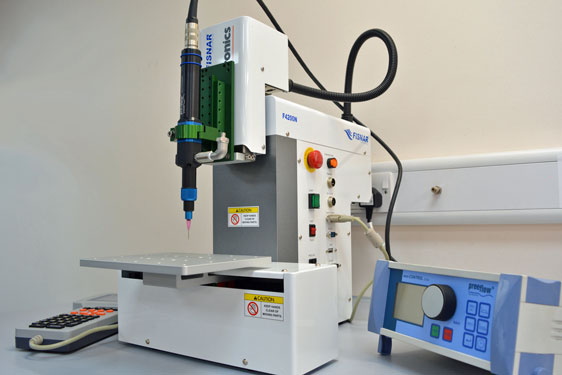Based in Boston, Lincolnshire, Parkinson Harness Technology is a manufacturer of bespoke electrical products to industries such as construction, agriculture, rail and defence. It produces a variety of products including wiring harnesses, control panels, battery/power leads, PCBs and control systems mainly for use in specialist vehicle manufacture. Parkinson Harness Technology also offers engineering support services across various stages of vehicle production design and testing.
The company was looking to satisfy a customer’s need for a way to pot a small electrical resistor into the bottom of a diesel filter bowl without compromising the connectivity of the copper pins. The process needed to be accurate, repeatable and reliable whilst minimising wastage of parts and material. It was difficult to apply the epoxy in the correct position because the resistor was inside a recess of the filter bowl and the dispensing equipment obscured the view. Previous methods for this process had proven problematic, with excessive epoxy resin being inaccurately dispensed, causing material to cover the copper pins and block electronic connectivity. The resulting levels of scrappage and material wastage led to reduced manufacturing yield.
Intertronics’ Product Specialist, Simon Gibbs, worked alongside Senior Development Engineer Clayton Smith to find an efficient way to pot the resistor with higher accuracy and precision than the existing method. He conducted a series of trials and demonstrations in order to establish a more suitable method of dispensing.
Describing the original process Clayton said: “Our existing process was just not working for us or the customer; we had a high failure rate and a lot of rejected material, so something needed to change.” He continued: “We looked at several different solutions from a handful of different companies, but the offering from Intertronics stood above the crowd. This, coupled with the positive approach from Simon Gibbs and everyone else on the Intertronics team, convinced us that we had found the right solution.”
Successful sample assemblies were created using a Fisnar F4200N.1 benchtop robot and a preeflow eco-PEN450 positive displacement valve. The easy-to-program F4200N.1 provided accurate, repeatable positioning of the valve over the component, whilst the preeflow eco-PEN450 volumetrically dispensed 0.2g of single-part, heat-cure epoxy resin onto the part.
Once satisfied, Clayton proposed this new process to the customer, who was happy to go ahead with the new method, resulting in better quality products at a reduced cost due to the reduced material waste and reject rates.



Taking steps toward reindustrialisation
High value is not the same as high cost/price and does not need excessive automation. Appropriate and innovative manufacturing tools are what led (in...